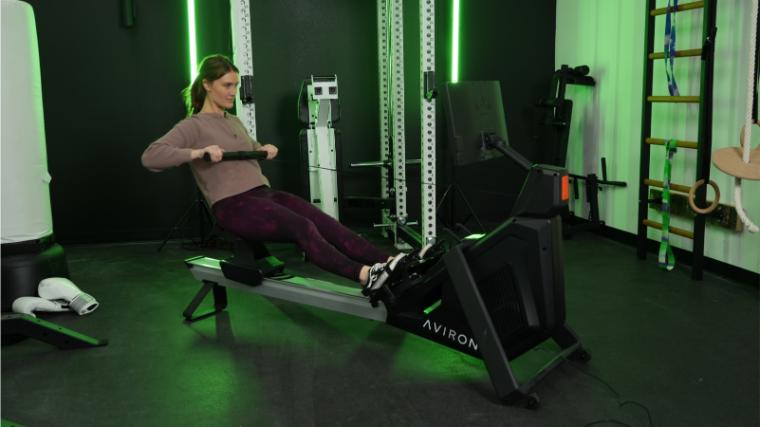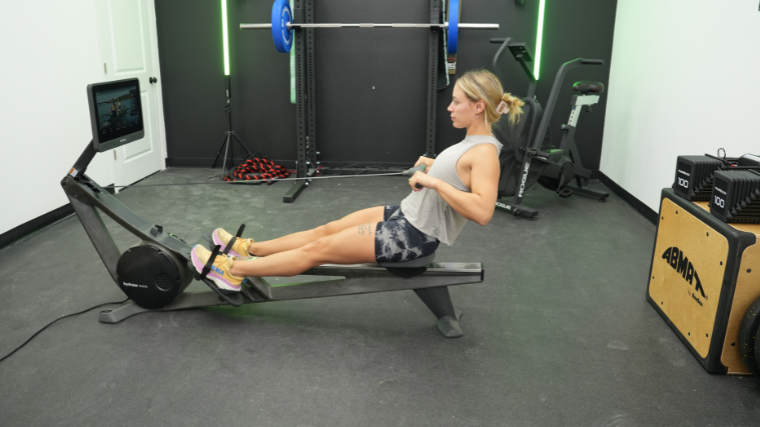[ad_1]
So you’re trying to figure out which cardio machine fits best into your training plan. If you’re itching for a truly full-body cardio workout that will put pretty much all your muscles to use, might I suggest the rowing machine?


It’s versatile: from your warm-up to an all-out HIIT (high-intensity interval training) session, you can do it all on a rowing machine. Plus, it’ll work most major muscle groups in your body — with none of the impact on your body of running or slinging barbells around. Here, I’ll break down the muscles the rowing machine works in each phase so you’ll know what to feel for, from head to toe.
What Muscles Does a Rowing Machine Work?
First and foremost, let’s give you what you came here for: that (hefty) list of different muscles that rowing machines work. (We’ll break down the hows and the whys later.)
- Quadriceps
- Hamstrings
- Glutes
- Calves
- Lats
- Traps
- Rhomboids
- Erector Spinae
- Triceps
- Biceps
- Deltoids
- Abdominals
See? I meant it when I said that rowers give you a head-to-toe total-body workout. It’s exhausting—and exhilarating—just reading this list.
How does the rower pull all of this off? Glad you asked.
When you hop on a rower and use proper form, you work your entire body in a cardiovascular exercise that combines the movements of a squat, hinge, pull, and (somewhat) push. The more explosive you are, the more the lower body move becomes like a jump squat—but your feet stay planted, so it’s low-impact. Plus, your core stays stable the whole time.
And it’s not just your muscles. Indoor rowing is great for aerobic exercise because it raises your heart rate and breathing quickly. So, in all phases, one of the most important muscles the rowing machine works is your heart.
[Read More: The Best Rowing Machine Workouts for Every Experience Level]
When you increase the resistance, your skeletal muscles need to work harder, making it great for building strength over time. At any resistance level, the greater your range of motion, the more energy you expend. This aspect makes it an excellent option for a high-intensity training with minimal impact on your joints. (1)
To get the most out of this great workout, I’ll explain which muscles do what in each phase: the catch phase, the drive phase, the finish phase, and the recovery phase. Let’s row.
The Catch Phase
The catch position is the starting position of the movement. Your hips are flexed, knees are bent, and you’re holding the handle with straight arms.
Your leg muscles, upper arms, and core are contracting here to help you build tension and prepare to move powerfully into the drive phase.
Lower Body:
- Quadriceps: In the catch position, your quads flex your hips, similar to the bottom of a squat. You want to keep your quads and hip flexors contracting rather than rounding your spine.
- Hamstrings: Your hamstrings help with knee flexion (or bending your knees). They contract here to keep them fully bent, with your shins perpendicular to the floor.
[Grow Your Muscles: Best Quad Exercises + Best Hamstring Exercises]
Upper Body:
- Triceps: Your triceps extend your elbow, so they’re working here to keep your arms straight before you prepare to row them in.
- Latissimus Dorsi: Your lats engage to depress your shoulder blades, setting you up for a powerful row.
[Grow Your Muscles: Best Triceps Exercises + Best Lat Exercises]
Core:
- Erector Spinae: Your erector spinae muscles help stabilize your lower back and lumbar spine, protecting them in this flexed position.
- Abdominal Muscles: Your rectus abdominis flexes your trunk and contracts in the catch position.
The Drive Phase
The drive phase is the explosive part of the rowing stroke. You push first with your feet and leg muscles, then use your core muscles to reach an upright position. You’ll keep your arms and wrists straight, and shoulders relaxed.
Lower Body:
- Calf Muscles: The gastrocnemius and the soleus plantarflex the ankle, so you can push your feet down as you drive back.
- Glutes: Glute muscles are responsible for hip extension as you straighten your legs.
- Hamstrings: Your hamstrings assist the glutes in hip extension.
- Quadriceps: During the drive, your quads trigger knee extension (straightening your knees).
[Grow Your Muscles: Best Calf Exercises + Best Glutes Exercises]
Core:
- Abdominal Muscles: All of your core muscles work to stabilize your spine and move your torso from flexed to upright. Your obliques prevent you from side bending.
The Finish Phase
The finish phase is where the core and upper body work the hardest — after you fully straighten your legs during the drive.
Lower Body:
- Quads and Glutes: As you fully straighten your legs, your quads and glutes contract to hold hip and knee extension.
Core:
- Abdominal Muscles: Your core muscles all contract to slightly lean your torso back while maintaining core tension.
- Erector Spinae: Your erector spinae continues to stabilize your lower back.
[Grow Your Muscles: Best Back Exercises + Best Ab Exercises]
Upper Body:
- Biceps: Your biceps assist in elbow flexion as you pull the handle toward your ribs.
- Latissimus Dorsi: As you row the handle, your lats help stabilize and depress your scapula.
- Deltoids: Your rear delts are your posterior shoulder muscles. They aid shoulder extension (pulling your arms back) and assist in scapular movements.
- Trapezius: Your trapezius, or traps, aid in retracting and stabilizing your scapula as you pull the handle toward your ribcage.
- Rhomboids: Your rhomboids are small muscles between your shoulder blades and aid in scapular retraction as you squeeze your shoulder blades together at the end of the drive phase.
[Grow Your Muscles: Best Biceps Exercises + Best Shoulder Exercises]
The Recovery Phase
The recovery phase essentially reverses everything you just did. Since you pushed with your legs first, then used your core, and finally rowed with your arms, now you recover in the reverse direction. Here’s what happens as you straighten your arms, lean forward, and rebend your hips and knees.
Upper Body:
- Triceps: Your triceps straighten your elbows as you push forward.
- Trapezius: Your trapezius also assists in the opposite movements that it just did in the finish phase: it helps protract (and stabilize) your scapula as you straighten your arms to reach forward.
- Rhomboids: Your rhomboids also assist in protracting your scapula to return to the catch.
[Grow Your Muscles: Best Trap Exercises + Best Rhomboid Exercises]
Core:
- Abdominal Muscles: Your rectus abdominis flexes your torso as you return to the catch.
Lower Body:
- Quadriceps: Your quadriceps work to flex your hips, as they would when you lower into a squat.
- Hamstrings: Your hamstrings aid in knee flexion or bending the knees as you return.
How to Use a Rowing Machine
Now that you know what’s working in each phase, here’s a simple step-by-step on how to use a rowing machine with good technique.


[Read More: The Best HIIT Rowing Workout, Customized to Your Experience Level]
There are many brands of rowing machines, including the Hydrow, Concept 2, and water rowers, but you’ll generally use the same form on each.
- Starting Position: Set your drag — which is not your resistance, which is provided by how hard you’re pulling. Adjust the footplates so the strap will secure your midfoot, and strap them in. Take the handle out of its holder. Hold it with an overhand grip and straight wrists.
- The Catch Phase: Lean your upper body forward until your shoulders pass your hips. Bend your knees fully and let your heels lift so you are as close as possible to the front.
- The Drive Phase: Push your feet down to drive, straighten your legs, and extend your hips. Keep your arms straight and spine neutral. Keep your core engaged as you lean into an upright position and then slightly back.
- The Finish Phase: Straighten your legs fully, then pull with your arms. Lean back as you use your back muscles to row the handle to the bottom of your ribcage. Keep your core tight.
- The Recovery Phase: Reverse the movement. Lean forward and straighten your arms, reaching toward the flywheel. Pass your knees with your hands and then bend your hips and knees. Return to the catch position, and repeat.
Note: Here, drag refers to the rate of deceleration applied to each stroke; a higher drag factor isn’t always, or even usually, the best. Try a three or six setting instead. With a lower setting, you’ll be rowing a lot faster, while with a higher setting, you’ll travel farther with each (more difficult) pull.
Frequently Asked Questions
Any more questions? That’s cool. We’ve still got answers.
Does a rowing machine help you gain muscle?
Since the rowing machine is primarily aerobic exercise, you won’t gain as much muscle as you can from strength training (and, of course, eating enough calories and protein).
To gain muscle from aerobic exercise, you have to do an extremely high volume with enough resistance for a longer period than you would in less time with resistance training. It may also be more likely for sedentary people and older adults. (2)
However, some research indicates the rowing machine can somewhat help build muscle, especially in slow-twitch muscle fibers. (3)
How long does it take to see results from rowing?
It depends on many factors, including the level of intensity of your workouts, the duration, resistance used, and frequency. It could take a few weeks or months, but newbies may see results sooner.
Where should you feel it when rowing?
Everyone’s body is different, so there’s no definitive answer to what everyone should feel. Generally speaking, you’ll likely feel your glutes, hips, and leg muscles work when you push, your upper arms, shoulders, and upper back when you pull, and your abdominal muscles throughout the movement.
Is the rowing machine good for belly fat?
No type of exercise can target belly fat specifically. If your goal is weight loss, the theory is to consume less calories than you burn. The rowing machine is a great cardio workout that raises your heart rate and can increase your total daily energy expenditure (TDEE), which may aid fat loss, including body fat in your midsection.
What muscles are not worked by rowing?
Rowing works most of the major muscle groups in your lower body. In your upper body, the primary movement is a pull, so your upper back and arms are involved. It doesn’t work your chest and most other pushing muscles.
How effective is a rowing machine for a full-body workout?
The rowing machine is pretty effective as a full-body cardio workout. Though it can help you gain some strength, it is less effective than resistance training for increasing strength and building muscle.
References
- Bell G, Bennett J, Reynolds W, Syrotuik D, Gervais P. A Physiological and Kinematic Comparison of two Different Lean Back Positions During Stationary Rowing on a Concept II Machine. J Hum Kinet. 2013 Jul 5;37:99-108.
- Konopka AR, Harber MP. Skeletal muscle hypertrophy after aerobic exercise training. Exerc Sport Sci Rev. 2014 Apr;42(2):53-61.
- Volianitis S, Yoshiga CC, Secher NH. The physiology of rowing with perspective on training and health. Eur J Appl Physiol. 2020 Sep;120(9):1943-1963.
[ad_2]
Source link
Fitnessnacks – #Muscles #Worked #Rowing #Machine #Row #Properly
Courtesy : https://barbend.com/rowing-machine-muscles-worked/
